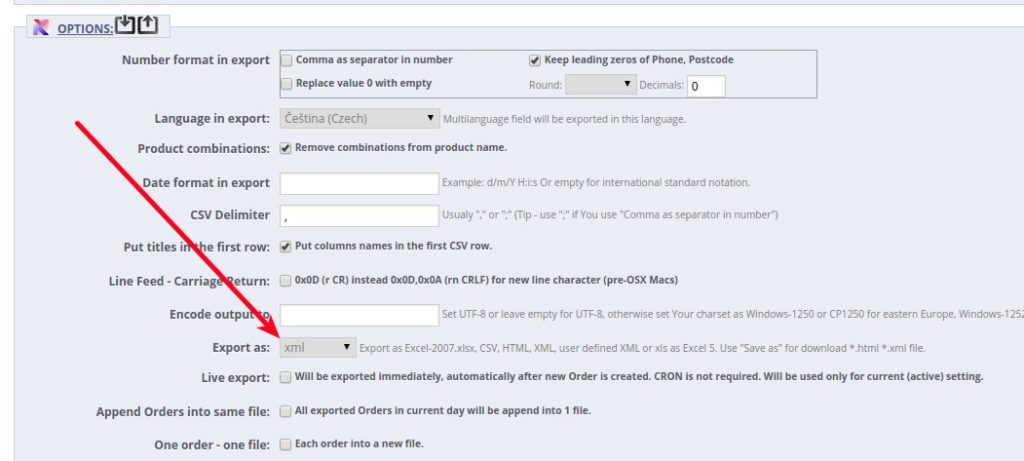Sample 1 – XML output grouped by Order ID
1/ add needed fields to export
2/ select “Export as” XML.
3/ Fill XSTL template and “Save”
That’s all.
.
.
Download example setting “nvn_settings.cfg” and import to module. Example setting is under “Setting 2”
Used XSLT:
<xsl:stylesheet xmlns:xsl="http://www.w3.org/1999/XSL/Transform" version="1.0">
<xsl:output omit-xml-declaration="yes" indent="yes" method="xml" version="1.0" />
<xsl:key use="order_id" match="/nvn_export_orders/order" name="groups"/>
<xsl:template match="/">
<xsl:apply-templates select="/nvn_export_orders" />
</xsl:template>
<xsl:template match="/nvn_export_orders">
<OrdersOut>
<xsl:for-each select="order[generate-id(.)=generate-id(key('groups',order_id))]">
<OrderSummary>
<OrderId>
<xsl:value-of select="order_id/text()" />
</OrderId>
<Orderdate>
<xsl:value-of select="date_add/text()" />
</Orderdate>
<Items>
<xsl:for-each select="key('groups',order_id)">
<ItemName>
<xsl:value-of select="product_name/text()" />
</ItemName>
<ItemQuantity>
<xsl:value-of select="product_quantity/text()" />
</ItemQuantity>
</xsl:for-each>
</Items>
</OrderSummary>
</xsl:for-each>
</OrdersOut>
</xsl:template>
</xsl:stylesheet>
Sample output:
<OrdersOut> <OrderSummary> <OrderId>1</OrderId> <Orderdate>2015-08-20 17:25:33</Orderdate> <Items> <ItemName>Blouse</ItemName> <ItemQuantity>1</ItemQuantity> <ItemName>Printed Dress</ItemName> <ItemQuantity>1</ItemQuantity> </Items> </OrderSummary> <OrderSummary> <OrderId>2</OrderId> <Orderdate>2015-08-20 17:25:33</Orderdate> <Items> <ItemName>Blouse</ItemName> <ItemQuantity>1</ItemQuantity> <ItemName>Printed Summer Dress</ItemName> <ItemQuantity>1</ItemQuantity> <ItemName>Printed Chiffon Dress</ItemName> <ItemQuantity>1</ItemQuantity> </Items> </OrderSummary> </OrdersOut>
Sample 2 – HTML output with images
setting is similar as in first sample, only add html extension for exported file:
Change XSTL:
Download example setting “nvn_settings.cfg” and import to module. Example setting is under “Setting 1”
Used XSLT:
<xsl:stylesheet xmlns:xsl="http://www.w3.org/1999/XSL/Transform" version="1.0">
<xsl:template match="order">
<xsl:variable name="image">
<xsl:value-of select="image_link"/>
</xsl:variable>
<xsl:variable name="price" select="product_price"/>
<xsl:variable name="quant" select="product_quantity"/>
<html>
<head>
<title>Order #<xsl:value-of select="order_id"/></title>
</head>
<body>
<div style="width:600px; background-color:Lavender; border:2px solid Red;">
<div style="float:right; background-color:#323438; border:2px solid Black;">
<img src="{$image}" height="100" width="100"/>
</div>
<h2>Order ID #<xsl:value-of select="order_id"/>
added: <xsl:value-of select="date_add"/></h2>
<div style="width:70%; background-color:#fef9a1; border:1px solid Gray;">
<span><b>Buyer: </b></span>
<span style="color:Red;">
<xsl:value-of select="first_name"/> <xsl:value-of select="last_name"/>
</span>
<p></p>
<span><b>Product: </b></span>
<span style="color:Blue;">
<xsl:value-of select="product_name"/>
</span>
<p></p>
<span><b>Product quantity: </b></span>
<span style="color:Green;">
<xsl:value-of select="product_quantity"/>
</span>
<p></p>
<span><b>Product price: </b></span>
<span style="color:Green;">
<xsl:value-of select="product_price"/>
</span>
</div>
<div style="width:100%; font-size: 28px; background-color:#b2fcd1; border-top:1px solid Gray;">
<span><b>Product price * Product quantity: </b></span>
<span style="color:Red;"><b>
<xsl:value-of select="$price*$quant"/>
</b></span>
</div>
</div>
<p>---------------------------------------------------------------</p>
</body>
</html>
</xsl:template>
</xsl:stylesheet>
Sample output:
For more samples visit this page: http://www.praotec.com/nvn-export-orders-page-of-xslt-samples/
Transformation step by step tutorial You can find here: http://www.praotec.com/nvn-export-orders-simple-xslt-transformation-sample-step-by-step/










Admitedly, you lose the flexibility of the scripting solution, but I would argue that if your dialog engine is built with a robust collection of rules, the extra flexibility is unnecessary, and ultimately more trouble than it s worth.
In truth, XSLT is not required in most case. Is useful only for special export. Usually normal export setting is sufficient. (scripting solution is still accessible via module extension)